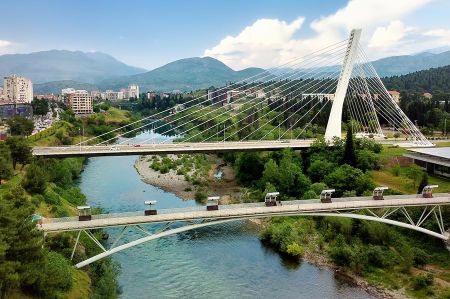Podgorica – today the cultural centre of Montenegro
- Written by Portal Editor
Our first encounter (about 15 years ago) with the capital of Montenegro was anything but pleasant, because a delivery truck had initially pushed the driver's door of our car in when we turned right and drove on without any reaction.
Then there was a truck accident on the then very narrow and partly unpaved E 762 towards the Hani I Hotit border crossing, which led to the road being closed and a long traffic jam.
Today Podgorica is considered the cultural centre of Montenegro, as the Montenegrin National Theatre, the Municipal Theatre, the Children's Theatre, the Puppet Theatre and many smaller theatres are based here. In addition to these theatres, which are known far beyond the country's borders, the City Museum, the Natural History Museum and the Dvorac Petrovića and Perjanički dom galleries are well-known exhibition sites of the eventful history of the city and the country, but more on that later.
Podgorica's varied history is also evident in its architecture
Of course, due to the city's truly changeable history in the last two centuries alone, one cannot expect a developed, uniform architecture in Podgorica, but rather a mixture of different styles, each depending on the cultural influences of those in power. For centuries under the rule of the Ottomans, Turkish influence shaped the city, as can be clearly seen in the mosques in the Stara Varoš and Drač districts. The Ribnica Delta in Morača is considered the historical centre of the city. For centuries, the delta has enriched city life with the charm of its wild nature and is often visited by the residents of Podgorica as a picnic spot - typically Turkish, actually.
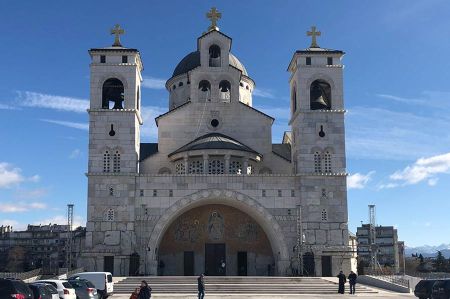 Podgorica was already part of the Ottoman Empire from 1466. The Ottomans built a large fortress here to protect themselves against attacks from the free Serbian-Montenegrin tribes from the mountains. With the construction of the fortress, the strategic importance of Podgorica continued to grow. At the Berlin Congress in 1878, Podgorica was awarded to the Principality of Montenegro, whose capital at that time was Cetinje. The results of the congress marked the end of four centuries of Ottoman rule. With the loss of power and fall of the Ottoman Empire before and during World War I, Podgorica was under Austrian occupation from 1916 to 1918. After losing the World War, the city became part of the Kingdom of Yugoslavia with the Kingdom of Montenegro in 1918.
Podgorica was already part of the Ottoman Empire from 1466. The Ottomans built a large fortress here to protect themselves against attacks from the free Serbian-Montenegrin tribes from the mountains. With the construction of the fortress, the strategic importance of Podgorica continued to grow. At the Berlin Congress in 1878, Podgorica was awarded to the Principality of Montenegro, whose capital at that time was Cetinje. The results of the congress marked the end of four centuries of Ottoman rule. With the loss of power and fall of the Ottoman Empire before and during World War I, Podgorica was under Austrian occupation from 1916 to 1918. After losing the World War, the city became part of the Kingdom of Yugoslavia with the Kingdom of Montenegro in 1918.
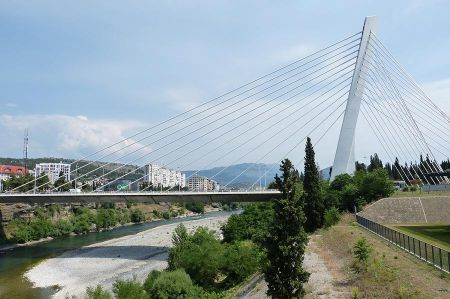 In the Second World War, the Italian occupiers (1941–1943) were followed by the Germans (1943–1944). The city was subjected to around 70 Allied air raids during the war, which almost completely destroyed it. It was liberated by the Yugoslav partisans in December 1944. In 1946 the city was renamed Titograd in honour of Yugoslav Prime Minister Josip Broz Tito and at the same time declared the capital of the Yugoslav republic of Montenegro. Since April 2, 1992 the city has been called Podgorica again. After the 2006 independence referendum, Podgorica became the capital of the new state of Montenegro.
In the Second World War, the Italian occupiers (1941–1943) were followed by the Germans (1943–1944). The city was subjected to around 70 Allied air raids during the war, which almost completely destroyed it. It was liberated by the Yugoslav partisans in December 1944. In 1946 the city was renamed Titograd in honour of Yugoslav Prime Minister Josip Broz Tito and at the same time declared the capital of the Yugoslav republic of Montenegro. Since April 2, 1992 the city has been called Podgorica again. After the 2006 independence referendum, Podgorica became the capital of the new state of Montenegro.
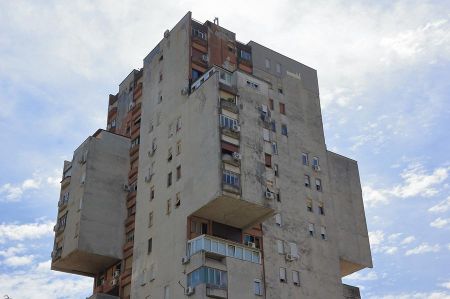 The reconstruction after the destruction in the Second World War was more oriented towards European influences. During the time of socialist Yugoslavia, mainly large apartment blocks were built. It was only in the late 1990s that more modern architecture began to take hold in Podgorica.
The reconstruction after the destruction in the Second World War was more oriented towards European influences. During the time of socialist Yugoslavia, mainly large apartment blocks were built. It was only in the late 1990s that more modern architecture began to take hold in Podgorica.
Glazed apartment houses and office buildings were built. A construction boom began, which has increased since independence in 2006.
Walking tour of the city of Podgorica
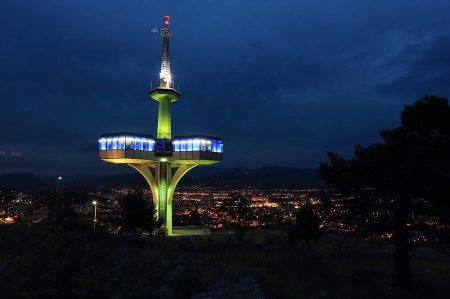 We begin our tour at the city museum almost as a journey into the past because Podgorica was first mentioned in documents in 1326 as a small settlement and for a long time stood in the shadow of Shkodra, Medun and the coastal towns of Bar and Budva, and later also of Cetinje.
We begin our tour at the city museum almost as a journey into the past because Podgorica was first mentioned in documents in 1326 as a small settlement and for a long time stood in the shadow of Shkodra, Medun and the coastal towns of Bar and Budva, and later also of Cetinje.
In the middle of the 14th century, Podgorica belonged to the Serbian empire of Tsar Stefan Dušan, then to the principalities of Balšić, Lazarević/Branković and Crnojević. The city was also briefly under Venetian rule.
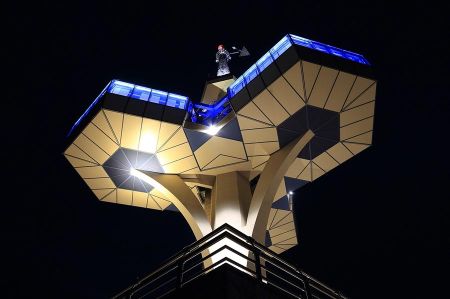 Due to the aforementioned Allied air raids, hardly any buildings have been preserved from this period. Just walking through the narrow streets of the old town makes you feel like you've been transported back in time, as the typical Turkish atmosphere of a bazaar district has been preserved. A little later we are at the Sahat Kula, at the clock tower, one of the few Ottoman buildings that survived the Second World War.
Due to the aforementioned Allied air raids, hardly any buildings have been preserved from this period. Just walking through the narrow streets of the old town makes you feel like you've been transported back in time, as the typical Turkish atmosphere of a bazaar district has been preserved. A little later we are at the Sahat Kula, at the clock tower, one of the few Ottoman buildings that survived the Second World War.
Podgorica is a city in which different cultures, religions and nations have mixed, as shown by the Orthodox, Catholic, Islamic and Jewish temples, which can be found here almost side by side and can also be visited in a comparative manner.
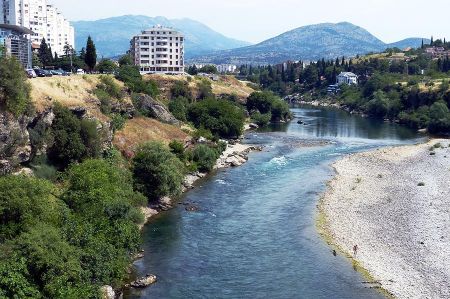 The ruins of ancient Doklee, dating from the first decade of the first century AD, are located about 4 km from Podgorica city centre. Those with cultural and historical interest should also visit the Marko Miljanov Museum and the village of Medun, where the remains of the Illyrian city of Meteon can be seen.
The ruins of ancient Doklee, dating from the first decade of the first century AD, are located about 4 km from Podgorica city centre. Those with cultural and historical interest should also visit the Marko Miljanov Museum and the village of Medun, where the remains of the Illyrian city of Meteon can be seen.
If the tour gets too warm, you can also try swimming in the Morača River. Podgoricans love it.
The so-called “Niagara Falls”, located 7 km from the city, is particularly beautiful in the winter months when there is a lot of water.
Today, the city's landmarks are the Orthodox Church of Hristovog Vaskrsenja (Church of the Resurrection) and the Millennium Bridge over the Morača River, which opened on July 13, 2005.
The culinary options should also be tried
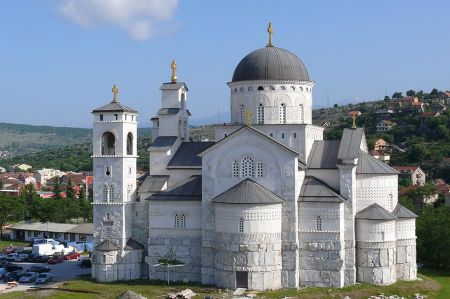 Why not try a Montenegrin wine during a break from exploring. Do they really do what the advertising promises? Between Podgorica and Lake Skadar there are thousands of vines full of grapes ready to be harvested in September. With a bit of luck, you can witness a local winemaker making his own wine and schnapps!
Why not try a Montenegrin wine during a break from exploring. Do they really do what the advertising promises? Between Podgorica and Lake Skadar there are thousands of vines full of grapes ready to be harvested in September. With a bit of luck, you can witness a local winemaker making his own wine and schnapps!
One of the most famous wine cellars called Šipčanik is located 30 meters underground, this fact alone is worth a visit. Tours and tastings are offered here all year round.
 Fish is offered in many different variations, a specialty in Podgorica is carp with plums. The desserts are influenced by Ottoman roots, such as baklava, tulumbe or the traditional bridal evening cake. Meat plays a central role and can be hearty. Grilled lamb is particularly popular.
Fish is offered in many different variations, a specialty in Podgorica is carp with plums. The desserts are influenced by Ottoman roots, such as baklava, tulumbe or the traditional bridal evening cake. Meat plays a central role and can be hearty. Grilled lamb is particularly popular.
The Njegusi schnitzel is also a popular specialty: it is spread with kaymak and topped with sheep's cheese and ham; Then it is rolled up with the filling, brushed with olive oil and dipped in beaten eggs and fried.
So staying for a few hours is quite interesting, even if it's just a stopover. By the way: If you would like to hike a section of the now well-known mountain hiking trail "Peaks of the Balkans", Podgorica is an excellent starting point, especially since the international airport is located here and the hiking trail connects the countries of Albania, Montenegro and Kosovo across the border. An article about the hike on sections of the "Peaks of the Balkans" route will follow shortly, or parts of it from Albania have already been described here:
Tour through the Kelmend into the Cem Gorge
Continuation of the journey through Kelmend into the Vermosh valley
Day trip to Kelmend through the Cem Valley
Please also read:
